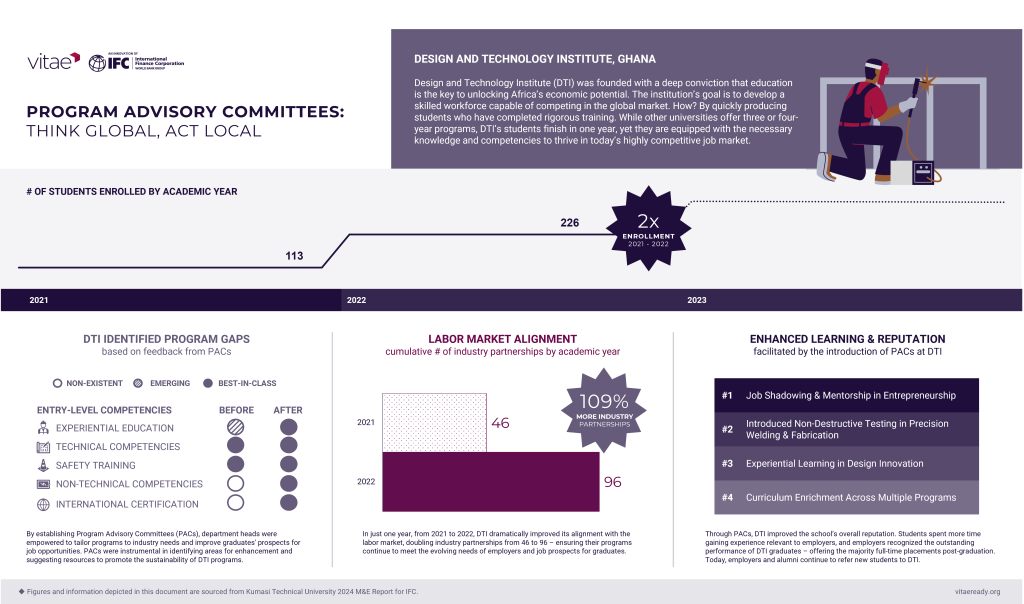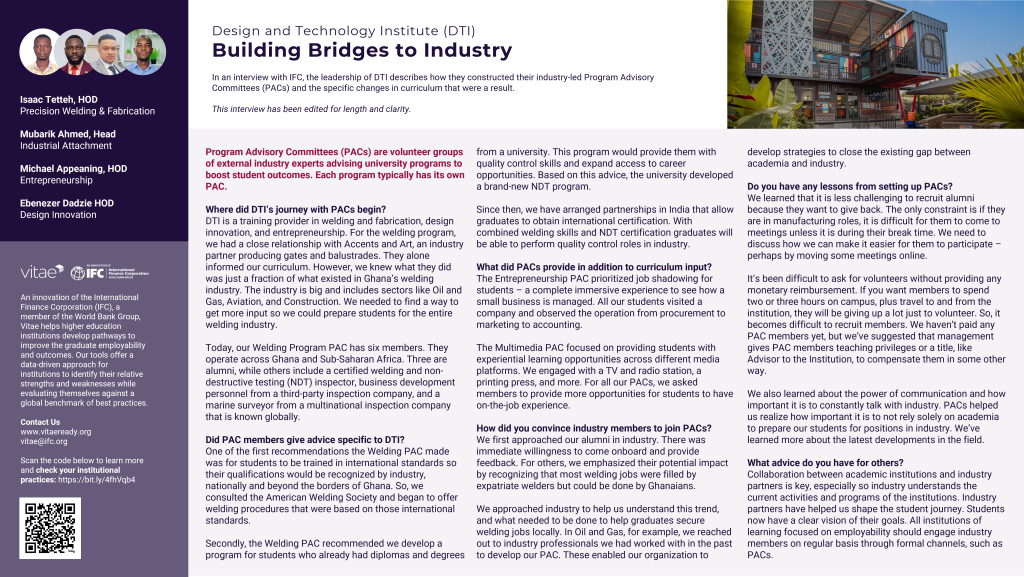Design and Technology Institute
Program Advisory Committees
Design and Technology Institute (DTI) was founded with a deep conviction that education is the key to unlocking Africa’s economic potential. The institution’s goal is to develop a skilled workforce capable of competing in the global market. How? By quickly producing students who have completed rigorous training. While other universities offer three or four-year programs, DTI’s students finish in one year, yet they are equipped with the necessary knowledge and competencies to thrive in today’s highly competitive job market.
Beginning in 2022, DTI participated in Vitae 360° Assessment and implementation support. Since then the institution has launched Program Advisory Committees (PACs) and reported notable improvements in industry partnerships and employment opportunities for graduates.
- 2X increase in annual enrollment
- 109% increase in industry partnerships
- Introduction of several new employability programs
Through PACs, DTI improved the school’s overall reputation. Students spent more time gaining experience relevant to employers, and employers recognized the outstanding performance of DTI graduates – offering the majority of full-time placements post-graduation. Today, employers and alumni continue to refer new students to DTI.
In an interview with IFC, the leadership of DTI describes how they constructed their industry-led Program Advisory Committees (PACs) and the specific changes in curriculum that were a result.
This interview was conducted with Isaac Tetteh, Head of Department (HOD) in Precision Welding & Fabrication, Mubarik Ahmed, Head of Industrial Attachment, Michael Appeaning, HOD in Entrepreneurship, Ebenezer Dadzie HOD in Design Innovation at DTI.
This interview has been edited for length and clarity.
Program advisory committees, also known as industry advisory committees, are volunteer groups of external industry experts advising university programs to boost student outcomes. Each program typically has its own PAC.
Q. Where did DTI’s journey with PACs begin?
DTI is a training provider in welding and fabrication, design innovation, and entrepreneurship. For the welding program, we had a close relationship with Accents and Art, an industry partner producing gates and balustrades. They alone informed our curriculum. However, we knew what they did was just a fraction of what existed in Ghana’s welding industry. The industry is big and includes sectors like Oil and Gas, Aviation, and Construction. We needed to find a way to get more input so we could prepare students for the entire welding industry.
Today, our Welding Program PAC has six members. They operate across Ghana and Sub-Saharan Africa. Three are alumni, while others include a certified welding and non-destructive testing (NDT) inspector, business development personnel from a third-party inspection company, and a marine surveyor from a multinational inspection company that is known globally.
Q. Did PAC members give advice specific to DTI?
One of the first recommendations the Welding PAC made was for students to be trained in international standards so their qualifications would be recognized by industry, nationally, and beyond the borders of Ghana. So, we consulted the American Welding Society and began to offer welding procedures that were based on international standards.
Secondly, the Welding PAC recommended we develop a program for students who already had diplomas and degrees from a university. This program would provide them with quality control skills and expand access to career opportunities. Based on this advice, the university developed a brand-new NDT program.
Since then, we have arranged partnerships in India that allow graduates to obtain international certification. With combined welding skills and NDT certification, graduates will be able to perform quality control roles in the industry.
Q. What did PACs provide in addition to curriculum input?
The Entrepreneurship PAC prioritized job shadowing for students – a completely immersive experience to see how a small business is managed. All our students visited a company and observed the operation from procurement to marketing to accounting.
The Multimedia PAC focused on providing students with experiential learning opportunities across different media platforms. We engaged with a TV and radio station, a printing press, and more. For all our PACs, we asked members to provide more opportunities for students to have on-the-job experience.
Q. How did you convince industry members to join PACs?
We first approached our alumni in the industry. There was an immediate willingness to come on board and provide feedback. For others, we emphasized their potential impact by recognizing that most welding jobs were filled by expatriate welders but could be done by Ghanaians.
We approached the industry to help us understand this trend, and what needed to be done to help graduates secure welding jobs locally. In Oil and Gas, for example, we reached out to industry professionals we had worked with in the past to develop our PAC. These enabled our organization to develop strategies to close the existing gap between academia and industry.
Q. Do you have any lessons from setting up PACs?
We learned that it is less challenging to recruit alumni because they want to give back. The only constraint is if they are in manufacturing roles, it is difficult for them to come to meetings unless it is during their break time. We need to discuss how we can make it easier for them to participate – perhaps by moving some meetings online.
It’s been difficult to ask for volunteers without providing any monetary reimbursement. If you want members to spend two or three hours on campus, plus travel to and from the institution, they will be giving up a lot just to volunteer. So, it becomes difficult to recruit members. We haven’t paid any PAC members yet, but we’ve suggested that management give PAC members teaching privileges or a title, like Advisor to the Institution, to compensate them in some other way.
We also learned about the power of communication and how important it is to constantly talk with industry. PACs helped us realize how important it is to not rely solely on academia to prepare our students for positions in industry. We’ve learned more about the latest developments in the field.
Q. What advice do you have for others?
Collaboration between academic institutions and industry partners is key, especially so the industry understands the current activities and programs of the institutions. Industry partners have helped us shape the student journey. Students now have a clear vision of their goals. All institutions of learning focused on employability should engage industry members on a regular basis through formal channels, such as PACs.
About Vitae
An innovation of the International Finance Corporation (IFC), a member of the World Bank Group, Vitae helps higher education institutions develop pathways to improve graduate employability and outcomes. Our tools offer a data-driven approach for institutions to identify their relative strengths and weaknesses while evaluating themselves against a global benchmark of best practices.

